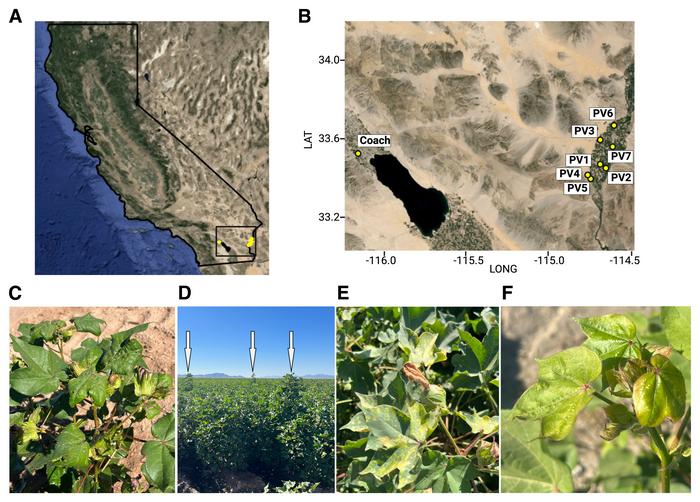A stealth pathogen has been silently undermining cotton fields across the southern United States for nearly two decades, eluding detection until only recently. New research has uncovered that cotton leafroll dwarf virus (CLRDV), once thought to be a new invader, has in fact been present in U.S. cotton crops since at least 2006. This discovery dramatically shifts our understanding of the virus’s timeline and geographic spread, with important implications for plant disease management and agricultural biosecurity.
Published in the prestigious journal Plant Disease, the study led by researchers from the USDA Agricultural Research Service in collaboration with Cornell University employed sophisticated data mining techniques in public genetic databases. By reanalyzing archived plant samples and genetic sequences, the team revealed clear viral footprints that predate CLRDV’s official detection by over a decade. This breakthrough demonstrates how leveraging existing biological data can expose hidden threats before they become widespread crises.
CLRDV, a member of the genus Polerovirus, is known to cause severe leafroll symptoms and dwarfing in cotton, significantly affecting yield and fiber quality. The disease was first officially detected in the U.S. in 2017, leading to concerns about its rapid emergence. However, the retrospective genomic analysis conducted by the team identified viral sequences in cotton samples from Mississippi dating back to 2006, alongside later occurrences in Louisiana (2015) and California (2018). These findings necessitate a reevaluation of CLRDV’s epidemiology in the U.S. Cotton Belt.
Adding to the urgency is the 2023 field survey conducted in Southern California by the research group, which confirmed the current presence of CLRDV in the region. This report marks California’s first verified documentation of the virus, indicating that CLRDV has established itself far beyond its previously understood range. The spatial expansion of this virus underscores the challenges faced by cotton producers in controlling viral pathogens amidst changing environmental and agricultural landscapes.
The study’s methodology highlights the power of bioinformatics in modern plant pathology. By mining genetic repositories and cross-referencing viral sequences, the researchers reconstructed a more comprehensive timeline of CLRDV’s introduction and dissemination within the United States. This approach also reveals the potential of public, accessible databases as crucial tools in emergent pathogen surveillance, enabling scientists to uncover latent threats hidden within existing data.
One particularly surprising dimension of the research was the identification of CLRDV genetic material in the gut content of a cow sampled in California. This finding, though not indicative of infection in the animal, suggests ingestion of virus-contaminated plant material, likely derived from infected cotton byproducts used in feed. This insight extends the ecological context of CLRDV and raises new questions about virus persistence and movement through agricultural systems.
Beyond merely redefining CLRDV’s timeline, the study probes deeper into longstanding agricultural puzzles — most notably, the enigmatic bronze wilt disease in cotton. The presence of CLRDV offers a plausible viral explanation for bronze wilt symptoms, which have been a source of debate in cotton pathology for years. Linking CLRDV to bronze wilt could revolutionize both diagnostic frameworks and management practices, providing a clearer path toward mitigating crop losses associated with this complex symptomatology.
Experts emphasize the critical implications for growers and agricultural stakeholders. Dr. Michelle Heck, a lead scientist on the project, warns that the virus’s historical invisibility should not breed complacency. Instead, understanding why CLRDV remained undetected for so long — despite its apparent widespread distribution — is vital in shaping future disease monitoring and intervention strategies. As the virus’s impact may be underreported, enhanced surveillance and integrated pest management approaches become all the more essential.
This research exemplifies the convergence of plant pathology, molecular biology, and data science, demonstrating how interdisciplinary strategies can unearth hidden biological signals to protect vital agricultural resources. The capacity to retrospectively analyze data transforms our ability to respond proactively to emerging phytopathogens, offering a model for combating viral diseases in other crops and geographic regions.
Looking forward, the study encourages investment in plant health infrastructure and database curation to sustain the efficacy of this modern disease detective work. The ability to detect pathogens hidden within "dark matter" of historical samples affords scientists and policymakers a powerful edge. It calls for global collaboration to build comprehensive, easily searchable repositories to facilitate rapid response in plant health crises.
Ultimately, the revelation of CLRDV’s long-standing presence in U.S. cotton fields is a wake-up call, illustrating that some of the most damaging threats to agriculture may be quietly festering out of sight. The use of bioinformatics and data mining not only rewrites the virus’s history but also charts a proactive path toward safeguarding crop health and ensuring food and fiber security against insidious viral adversaries.
The insights generated from this study set a new standard for the role of open data in plant disease epidemiology, highlighting the untapped insights locked away in archived collections and public datasets. As plant viruses remain a significant threat worldwide, this pioneering work underscores the importance of continual vigilance and innovation, from laboratory benches to cotton fields stretching across continents.
Subject of Research: Cotton leafroll dwarf virus (CLRDV) presence and historical spread in U.S. cotton fields.
Article Title: Data Mining Redefines the Timeline and Geographic Spread of Cotton Leafroll Dwarf Virus
News Publication Date: 20-May-2025
Web References:
https://doi.org/10.1094/PDIS-06-24-1265-SC
References:
Olmedo-Velarde, A., Heck, M., et al. "Data Mining Redefines the Timeline and Geographic Spread of Cotton Leafroll Dwarf Virus." Plant Disease, 20 May 2025. DOI: 10.1094/PDIS-06-24-1265-SC
Image Credits:
Courtesy of Alejandro Olmedo-Velarde and Michelle Heck — © 2025 The American Phytopathological Society.
Keywords:
Cotton, Plant pathology, Virology, Pathogens, Microorganisms, South America, North America, Farming, Sustainable agriculture, Data mining




